Ok...first off I need to say this. This knife is not a typical "bushcraft" knife. In fact many of you would probably liken it to a small machete. From the outset of working with this knife I had no intentions of reviewing it here being as it is not the type of knife usually discussed on this forum (however some of the things I did with it are) and I have been fussed at before here for usually working with larger knives. I understand and respect the philosophy behind those thoughts. They have actually inspired me personally to work more with smaller knives and exercise some brain-over-brawn techniques. However I still refused to fit so easily into any one box, and I work with a variety of knives. A Royal Marine chimed in on the review of this knife on another forum and a thought dawned on me; soldiers are often bushcrafters as well. It is these men I thought this review might appeal to. This knife is not designed to be "tacticool", rather it is very much designed to be tactical. It is the big brother of a knife expressly designed for the U.S. Navy S.E.A.L. Teams. It is not meant as a bushcrafting knife, it is as a knife for THE BUSH as seen from a soldiers perspective.
So...now you have been warned because I'd much rather you not waste your time reading about that which you have no interest in than to have you read it, not enjoy it, and then feel compelled to complain about the content.
Now, for anyone still reading, here goes. I have had the pleasure of working with a few knives made by SOG in the past and I have always been very happy with their performance. Recently I was fortunate enough to be given the opportunity to check out one of their newest knives. I have spent the last few days working with the most recent addition to SOGs Elite series of knives, the new Tigershark Elite, and I've had some fun with it.
Even though I had read the specs on the SOG website more than once I was still not quite prepared for the knife I was about to pull out of the box. Grabbing the handle and feeling the comfortable contours and very sure grip of the molded Zytel handle instantly brought a smile to my face, and pulling the blade from the cardboard sleeve broadened it. The Tigershark Elite has a black TiNi coated blade with an over-all blade length of 9 inches, so even with the 2 inch section of very wicked serrations and the 1 inch choil it still has a full 6 inches of plain edge for clean cutting and chopping. The blade is .25 inches thick and is 1.6 inches in width at the widest point. It has wonderfully precise grind lines, and the same scalloped spine that has become SOGs hallmark. However this spine has a rasped texture that offers more positive control when using the thumb ramp and choil, or when holding the knife by the blade to do more tedious detail work.
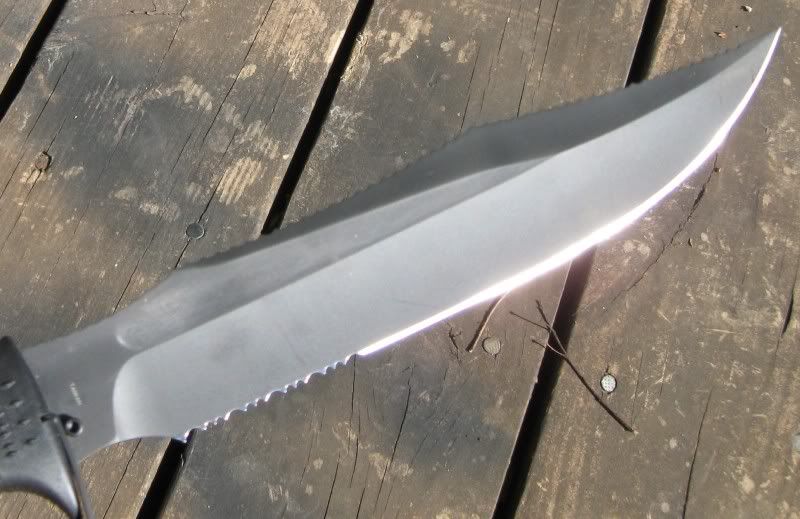
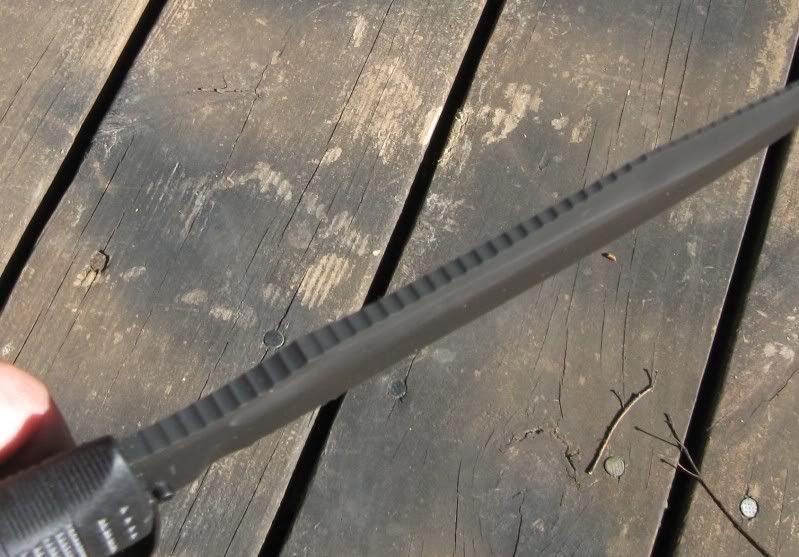
The edge is, as is customary with their knives, extremely sharp and shaved hair from my arm as cleanly as a straight razor.
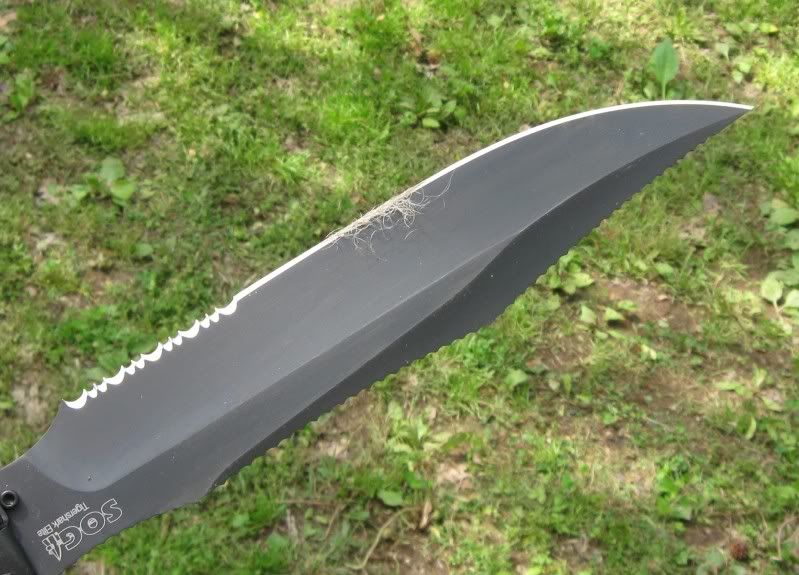
Also in the box are a couple of new additions to the Tigershark; a wrap-around steel hand guard and a heavy pointed pommel that come packaged separately. These are easily attached via slots in the handle and the protruding tang by following the enclosed instructions and they are held in place with six socket head screws which are tightened using two L shaped hex keys which are included in the package.
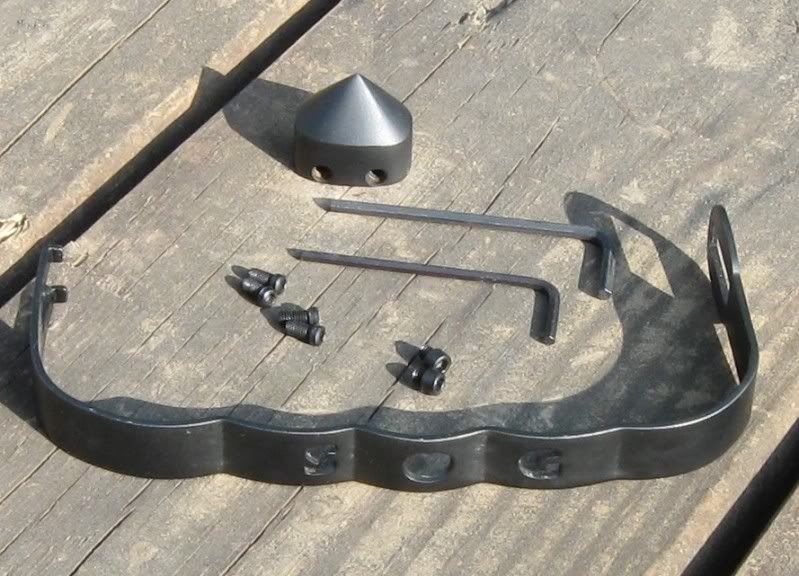
With the guard attached the knife takes on the appearance and feel of a small saber. The sheath is made of black nylon and has hard plastic sheeting sewn in for reinforcement in hi-stress areas. It has a large stone pouch on the front, and metal grommeted eyelets at the base of the belt loop, and at the tip to provide multiple carry options.
The pouch is large enough to accomodate the SOG Power Lock; a multitool with gear driven compound leverage that also incorporates some features speciffically gear to the soldier in the field. Coupling the muti-tool with this knife puts a lot of capability in one convenient package.

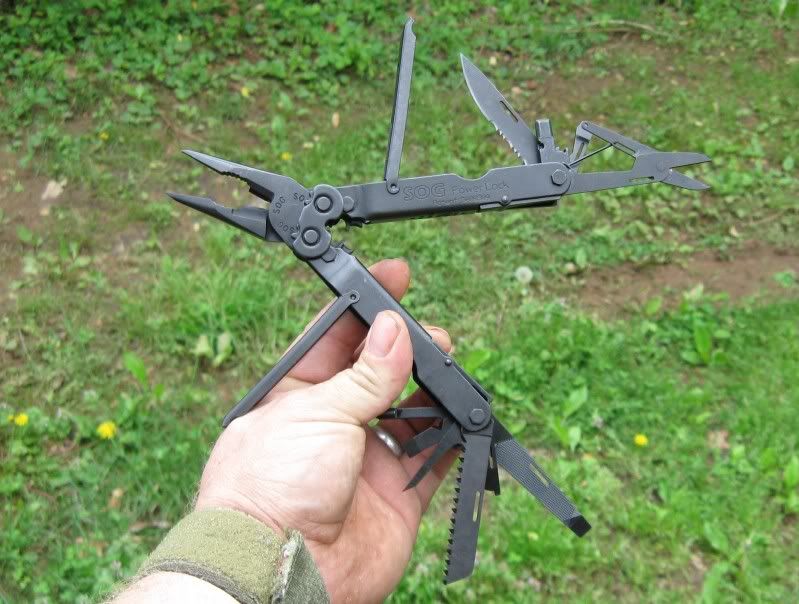

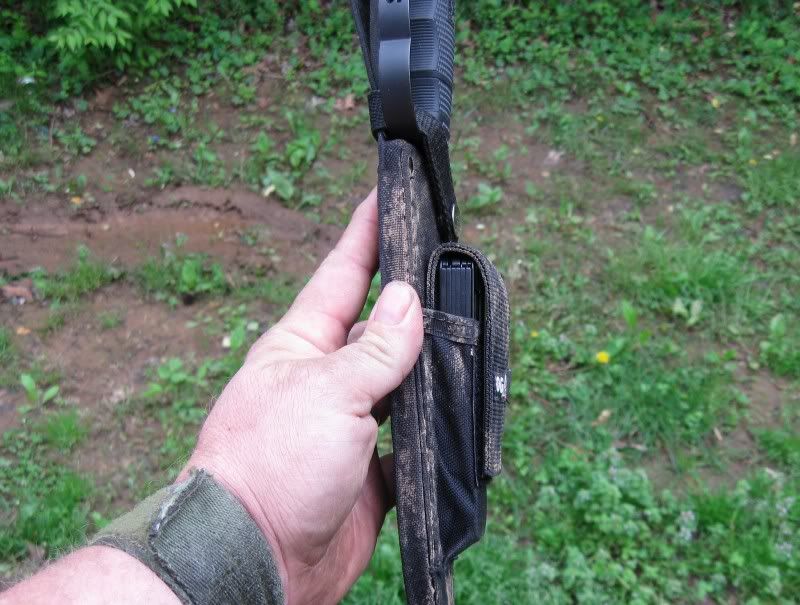
The sheath of this knife has an extra wide belt loop that easily slips onto a modern pistol belt without having to disassemble one end of the belts fastening assembly. The button snap of the retention strap is not too easily released but can be worked with the tip of one finger. There is no struggle when drawing the blade as it pulls out very quietly with little resistance and is returned just as easily. On the belt it wears very comfortably and, though the presence of the knife is noticeable, it does not feel excessively heavy. With the handguard attached the retention system is one of the most secure I have ever seen; it absolutely secures the knife in the sheath and allows for very little movement. However without the guard in place it is a bit less secure.
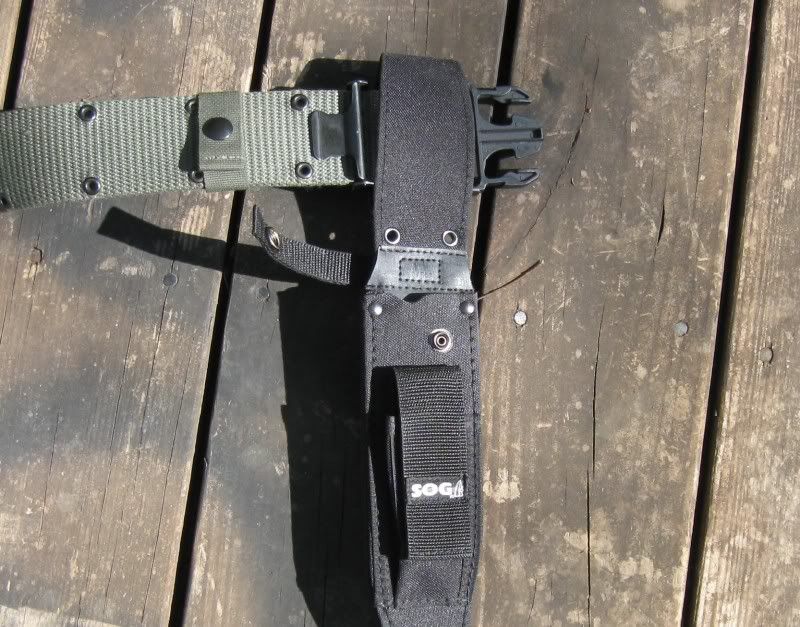
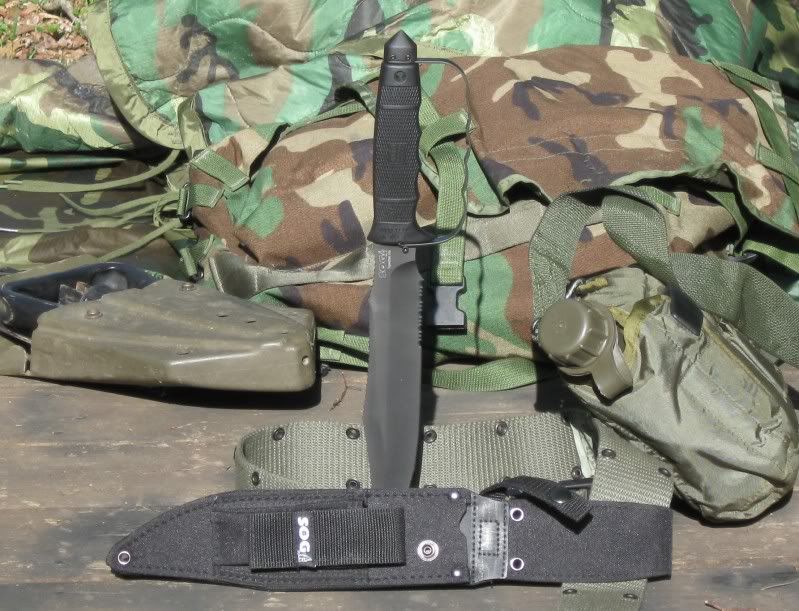
You can tell just as looking at the Tigershark that it is a knife on the cutting edge of tactical technology, and feeling the edge quickly lets you know that SOG is still producing some of the worlds sharpest blades. It cut through double layers of heavy weave nylon webbing with ease and cut through canvas as if it were just a sheet of cotton.
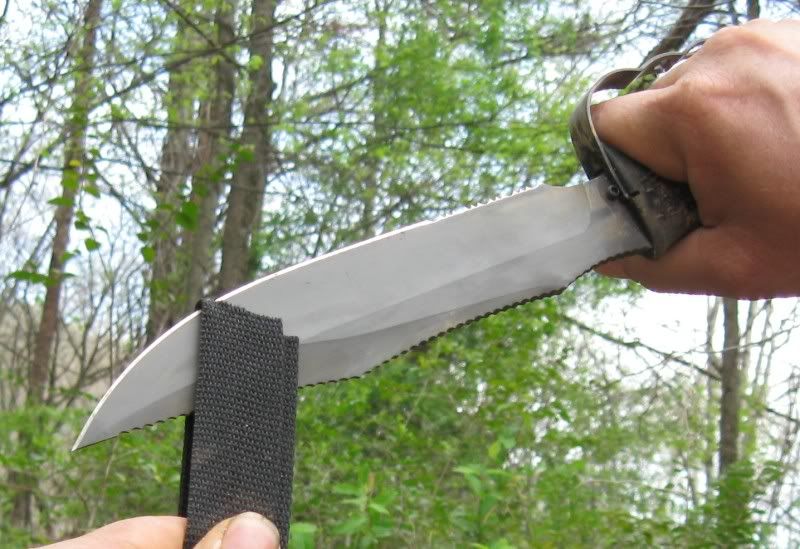
Using the thumb ramp and choil I was able to comfortably choke up on the blade and do detail work like cutting stakes and sharpening points with the part of the edge just in front of the serrations with a surprising degree of control.

and the rasp spine allows for good control when holding the knife by the blade. It also works well with a fire steel as I have already demonstrated with another knife from SOG's Elite line.
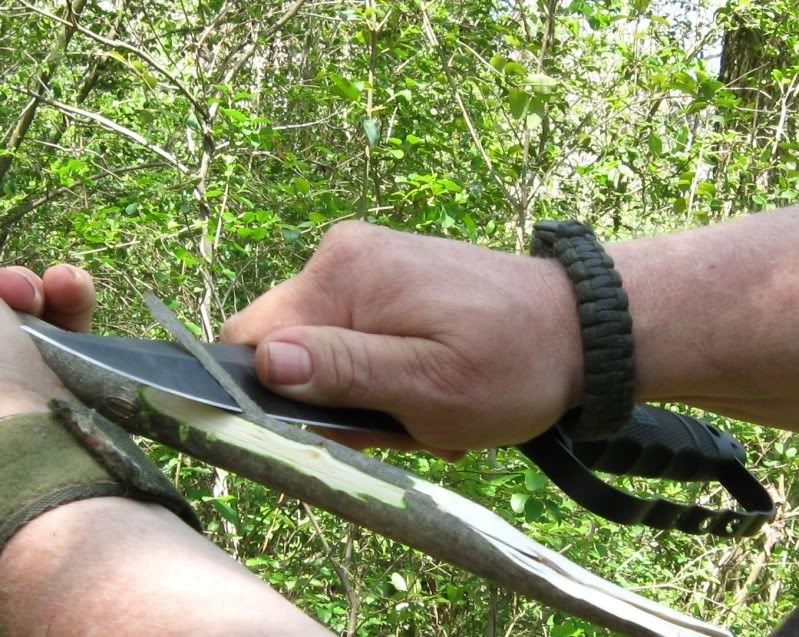
The physics are such that the balance point is exactly where the handle meets the blade and even with such a large blade using it in this fashion wasnt awkward at all.

Out in the field large tasks call for large tools. To see what this knife is really made of I set about constructing a hill-top Observation Post/ Firing Position. I wanted to see just how well it would perform when it was time to get down and dirty. Digging into the wooded hilltop the serrations soon made their worth obvious by making short work of quietly cutting through roots rather than noisily chopping through them with my E-tool.
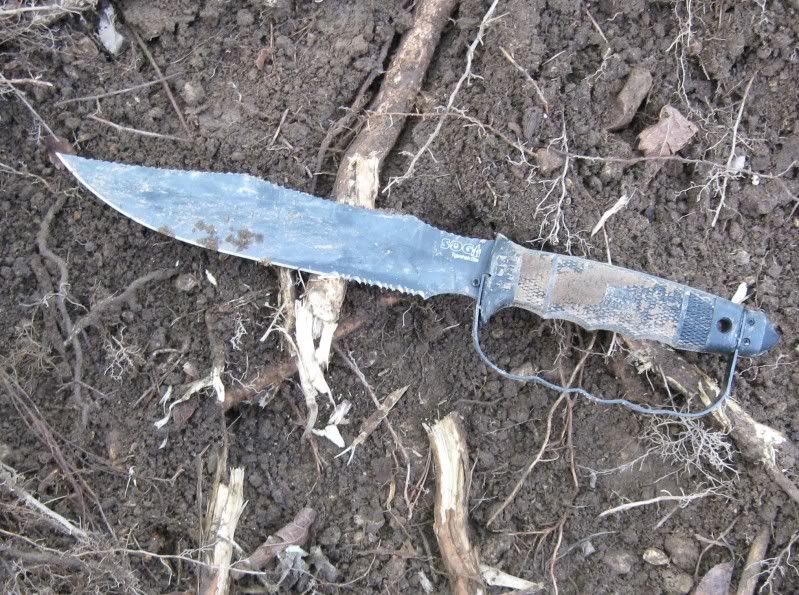
In the process of constructing the top the fantastic weight distribution and length of the blade along with the excellent ergonomics and positive grip of the handle made it possible to chop through all of the two and three inch hardwood saplings in just two and three quick cuts per each.
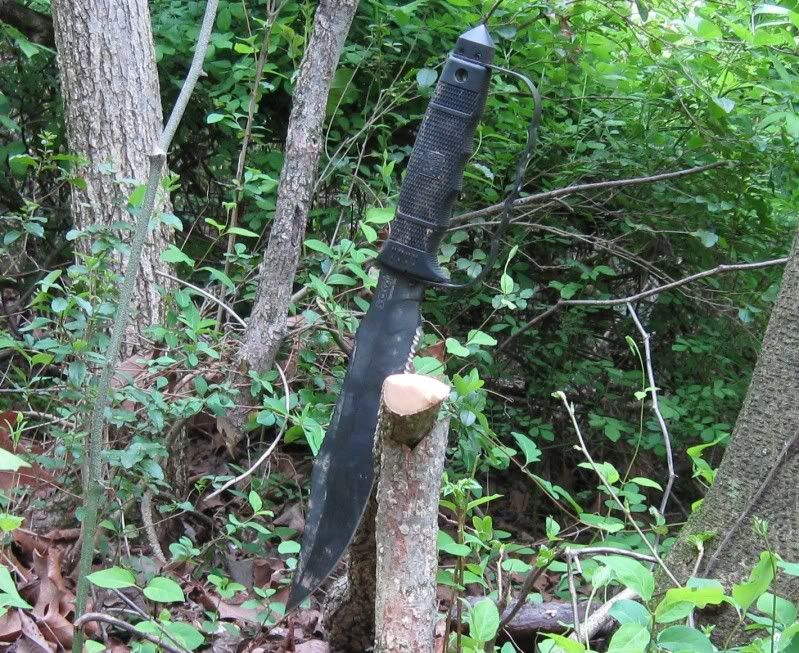
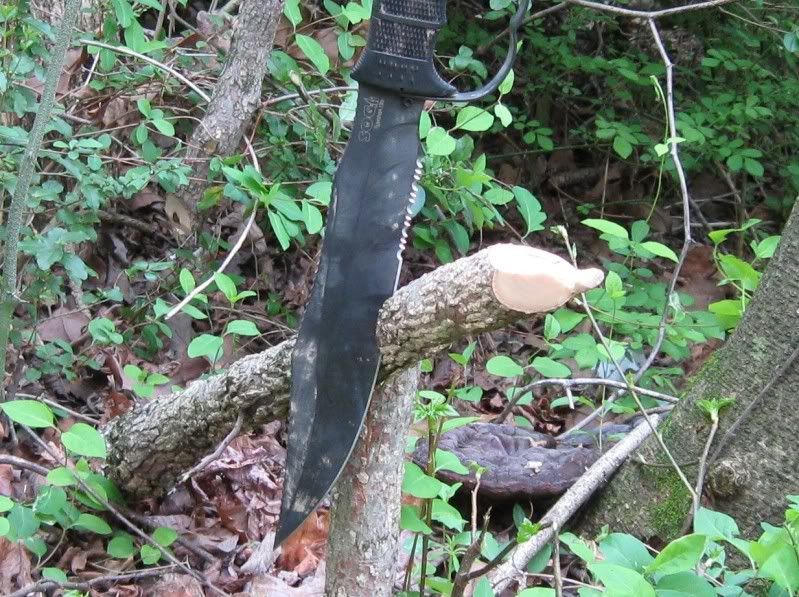
I was able to slash through all of the smaller saplings I used for camouflage and concealment in just one clean cut each. It was soon obvious that this knife would definitely be a great one to have along on patrol if one suddenly needed to cut saplings and chop down small trees in order to make a clearing to use as an L.Z. for an emergency extraction.
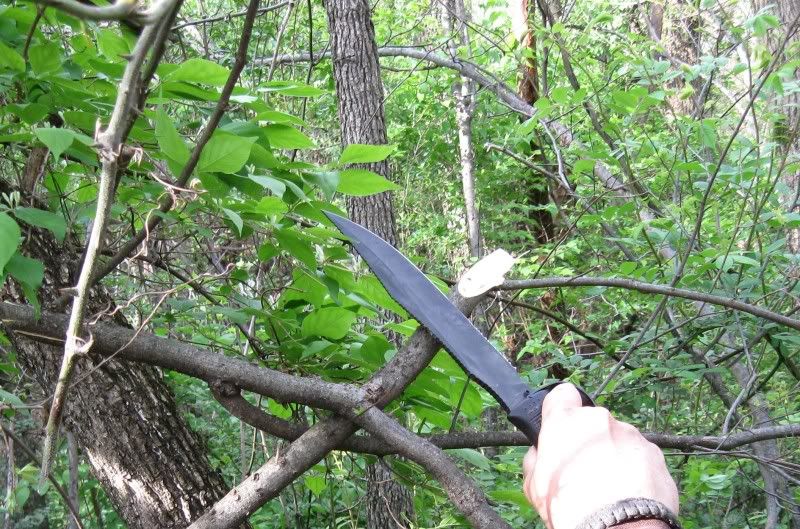
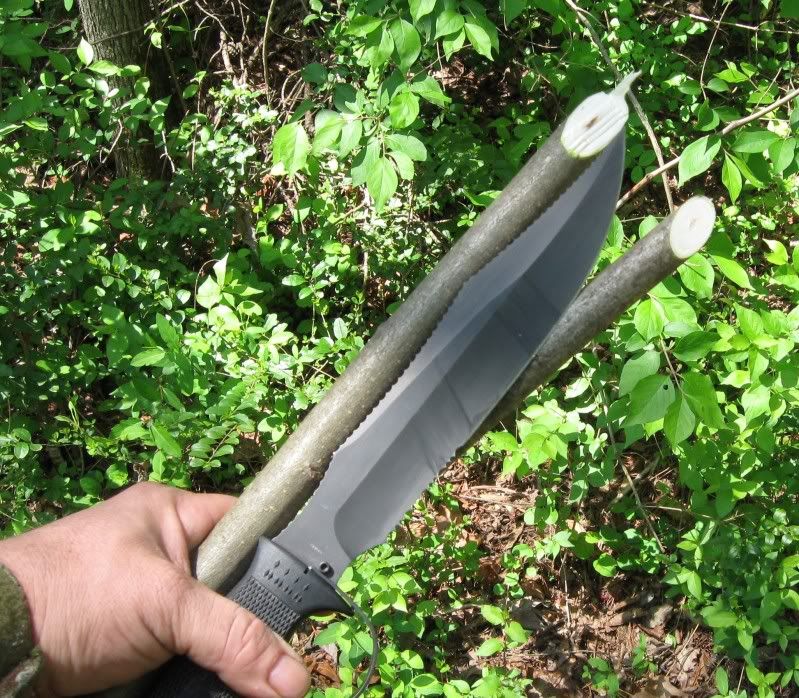
The new handguard does serve very well in protecting the fingers when cutting through vicious briars and brambles. It was a great advantage when I slashing through underbrush to reach my intended position, and when I was creating holes in the foliage for a clear line of sight. I am sure it would also be a big plus in a fight to protect the fingers during offensive slashes and punches, and any misplaced blows, as well as from disarming strikes from an opponent. The pointed heavy steel pommel will work great for breaking glass and punching holes in thin metal. It would undoubtedly be a very effective tool for cracking skulls and delivering other disabling blows in the frenzy that is close quarter combat.
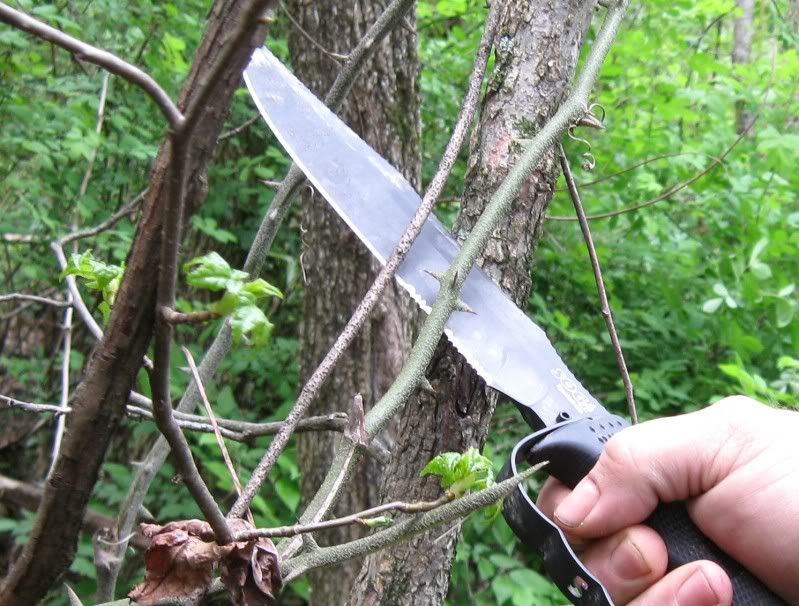
After seeing how well the Tigershark Elite held up to the larger chores of field craft it was time to see how well it could handle some of the smaller ones. I set out to perform some tasks commonly performed in the field and in stranded or survival situations. First I worked on trap components by cutting the multi-notched sticks for a figure-four trap trigger to use with a dead-fall, and it handled that very well.
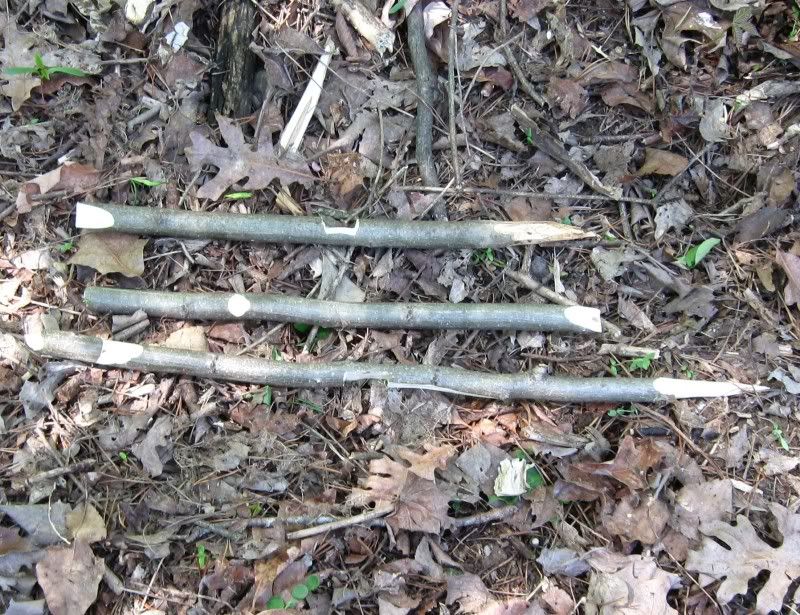
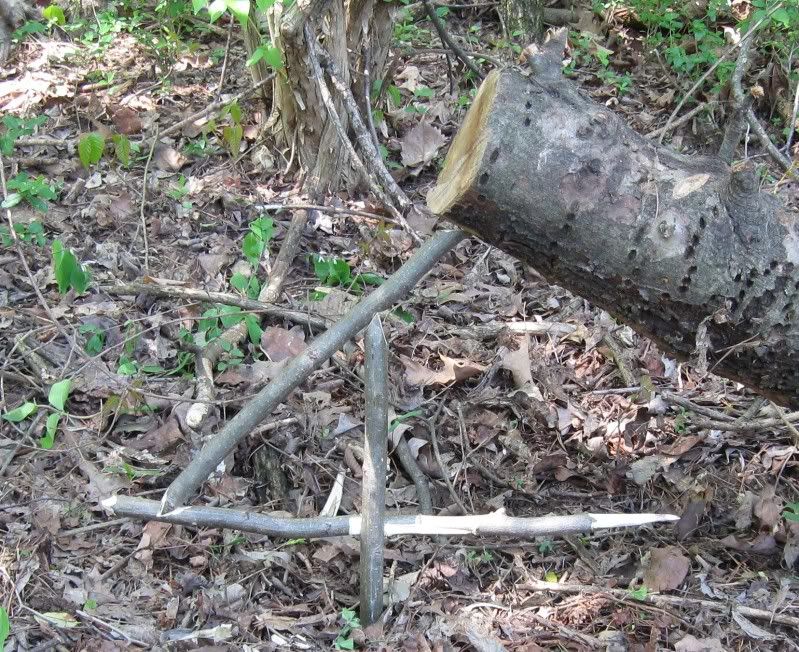
Then having found the perfect location I decided to try something a bit more complicated by setting up a bird snare. This involved boring an inch and a half deep hole through the side of a partially hollow birch tree.
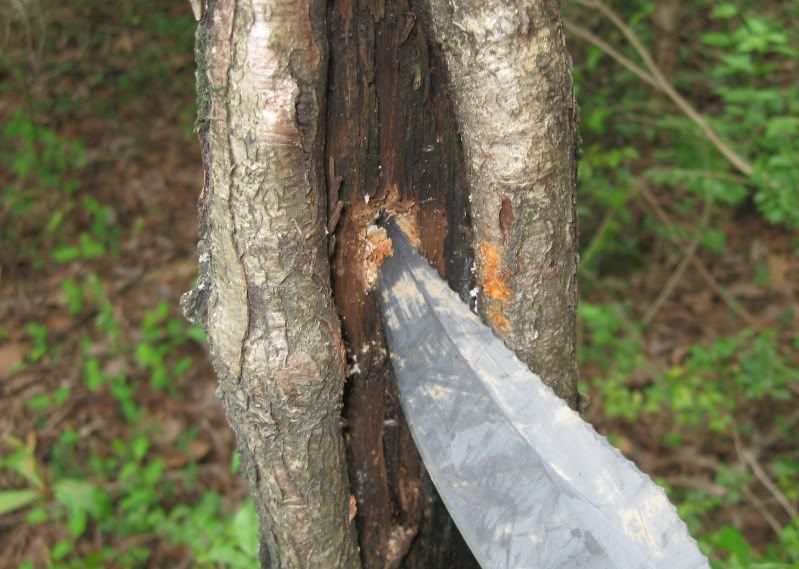

And afterwards there was no tip failure at all
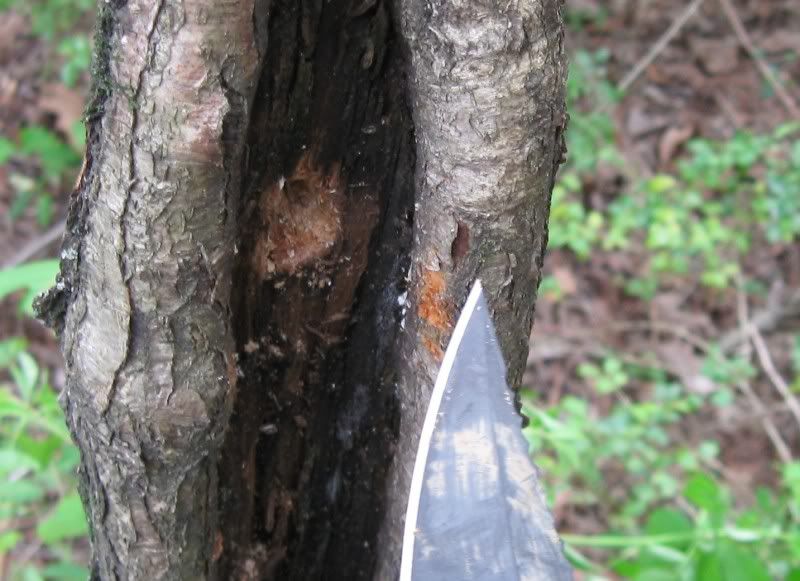
Lopping the off top of an adjacent sapling at just above head height to use for the tension.
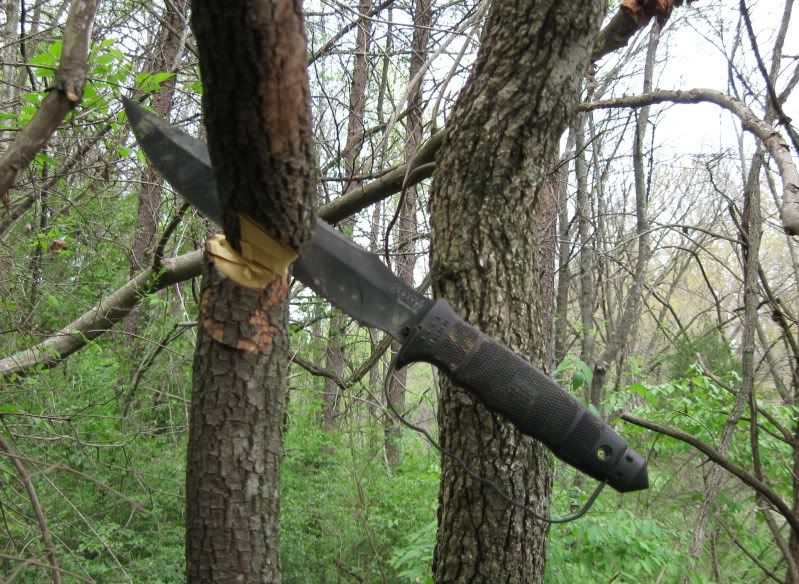
and whittling a small forked stick to use as a trigger.

The knife handled all three tasks like a true champion. Boring the hole gave the tip a good workout and it handled it just fine with no failure at all. Using the thumb ramp and choil I was easily able to whittle out the trigger and the length and weight of the knife made the over-head chopping very easy. The bird snare looked like this when I got done with it. (It should be stated here that inexperience with or mishandling while working with snare traps can lead to injury.)
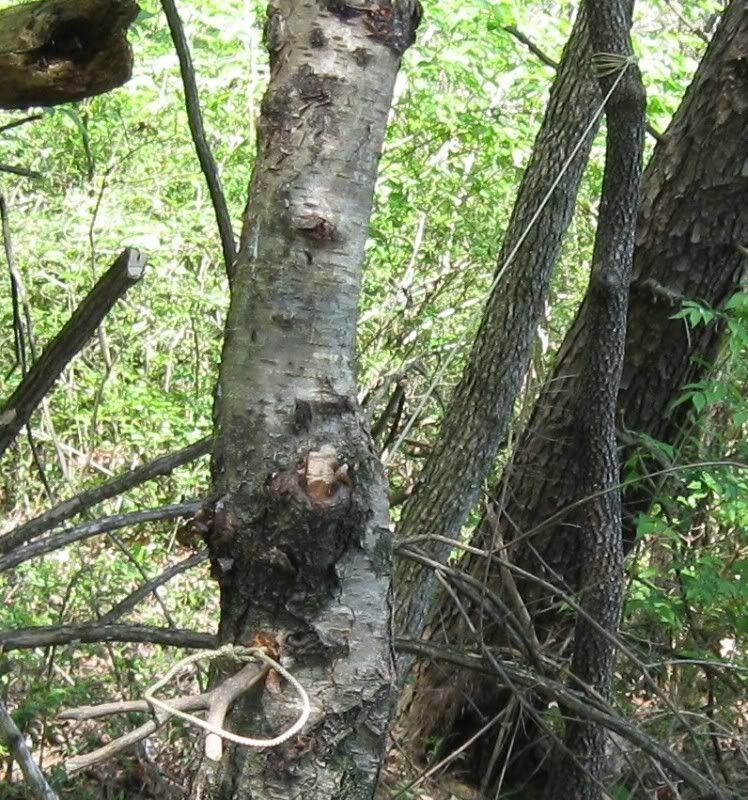
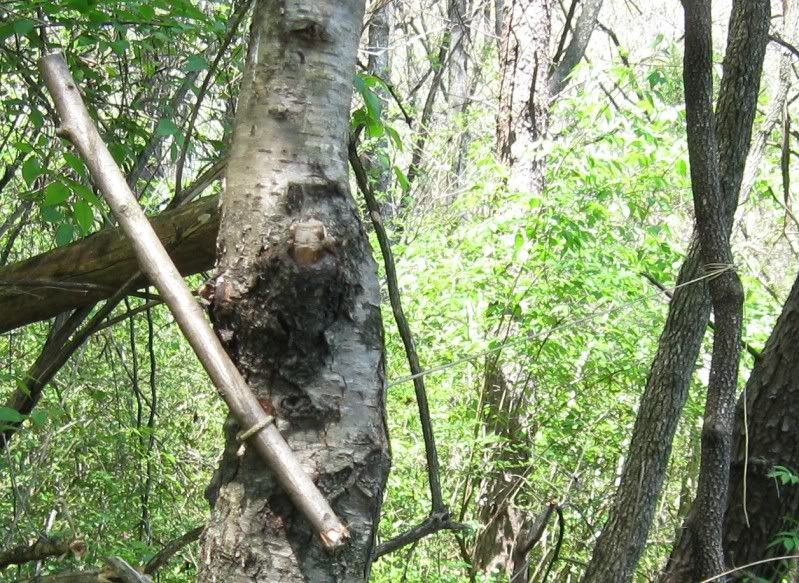
Over the course of the last three sometimes rainy days in the woods this knife has cut through rope and cordage, whittled points, carved notches, sliced through webbing and canvas, hacked through briars, chopped down small trees, sawed through roots, and bored a decent sized hole through some hard Birch. The once clean lines have now gotten quite dirty.
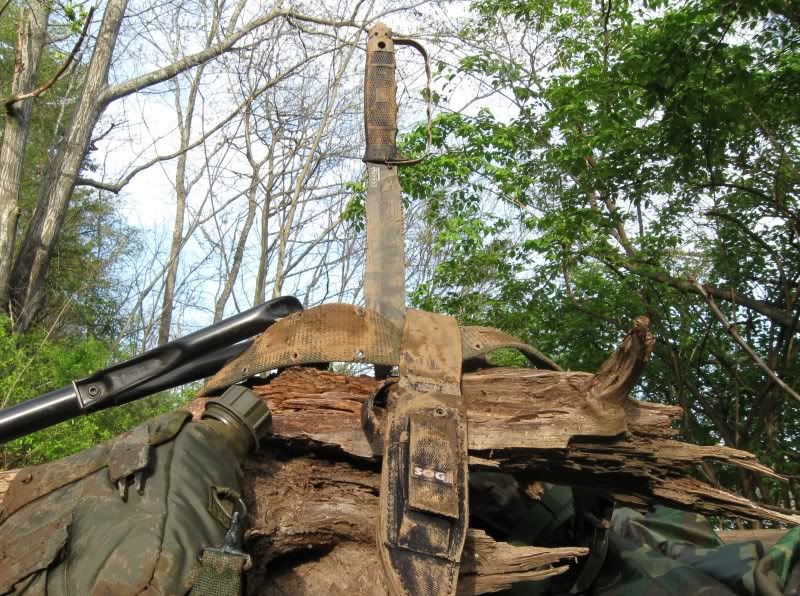
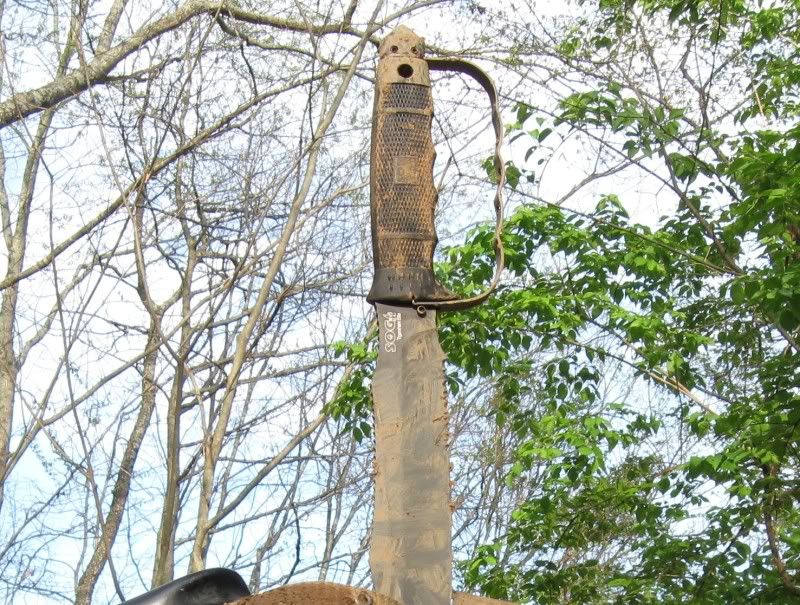
but Giving it a good bath reveals that there is very little sign of wear in the TiNi coating, the only visible wear is just above the serrations from the sawing of the roots. There are no nicks in the blade at all and the edge still shaves.
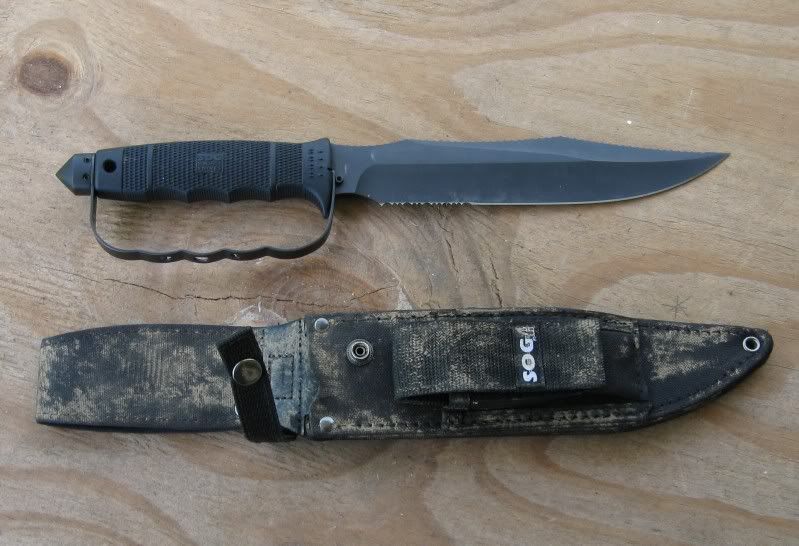
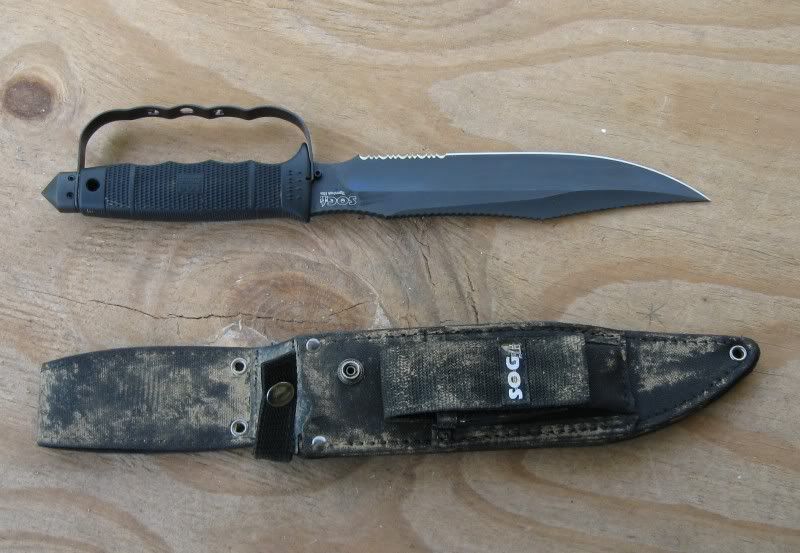
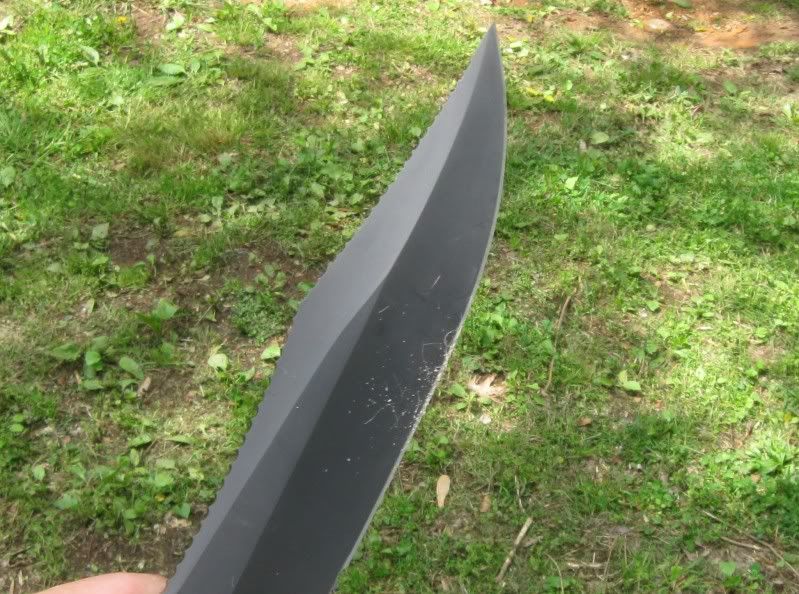
Other than the sheath is now a bit stained there really are no obvious signs of wear.
So...now you have been warned because I'd much rather you not waste your time reading about that which you have no interest in than to have you read it, not enjoy it, and then feel compelled to complain about the content.
Now, for anyone still reading, here goes. I have had the pleasure of working with a few knives made by SOG in the past and I have always been very happy with their performance. Recently I was fortunate enough to be given the opportunity to check out one of their newest knives. I have spent the last few days working with the most recent addition to SOGs Elite series of knives, the new Tigershark Elite, and I've had some fun with it.
Even though I had read the specs on the SOG website more than once I was still not quite prepared for the knife I was about to pull out of the box. Grabbing the handle and feeling the comfortable contours and very sure grip of the molded Zytel handle instantly brought a smile to my face, and pulling the blade from the cardboard sleeve broadened it. The Tigershark Elite has a black TiNi coated blade with an over-all blade length of 9 inches, so even with the 2 inch section of very wicked serrations and the 1 inch choil it still has a full 6 inches of plain edge for clean cutting and chopping. The blade is .25 inches thick and is 1.6 inches in width at the widest point. It has wonderfully precise grind lines, and the same scalloped spine that has become SOGs hallmark. However this spine has a rasped texture that offers more positive control when using the thumb ramp and choil, or when holding the knife by the blade to do more tedious detail work.


The edge is, as is customary with their knives, extremely sharp and shaved hair from my arm as cleanly as a straight razor.

Also in the box are a couple of new additions to the Tigershark; a wrap-around steel hand guard and a heavy pointed pommel that come packaged separately. These are easily attached via slots in the handle and the protruding tang by following the enclosed instructions and they are held in place with six socket head screws which are tightened using two L shaped hex keys which are included in the package.

With the guard attached the knife takes on the appearance and feel of a small saber. The sheath is made of black nylon and has hard plastic sheeting sewn in for reinforcement in hi-stress areas. It has a large stone pouch on the front, and metal grommeted eyelets at the base of the belt loop, and at the tip to provide multiple carry options.
The pouch is large enough to accomodate the SOG Power Lock; a multitool with gear driven compound leverage that also incorporates some features speciffically gear to the soldier in the field. Coupling the muti-tool with this knife puts a lot of capability in one convenient package.




The sheath of this knife has an extra wide belt loop that easily slips onto a modern pistol belt without having to disassemble one end of the belts fastening assembly. The button snap of the retention strap is not too easily released but can be worked with the tip of one finger. There is no struggle when drawing the blade as it pulls out very quietly with little resistance and is returned just as easily. On the belt it wears very comfortably and, though the presence of the knife is noticeable, it does not feel excessively heavy. With the handguard attached the retention system is one of the most secure I have ever seen; it absolutely secures the knife in the sheath and allows for very little movement. However without the guard in place it is a bit less secure.


You can tell just as looking at the Tigershark that it is a knife on the cutting edge of tactical technology, and feeling the edge quickly lets you know that SOG is still producing some of the worlds sharpest blades. It cut through double layers of heavy weave nylon webbing with ease and cut through canvas as if it were just a sheet of cotton.

Using the thumb ramp and choil I was able to comfortably choke up on the blade and do detail work like cutting stakes and sharpening points with the part of the edge just in front of the serrations with a surprising degree of control.

and the rasp spine allows for good control when holding the knife by the blade. It also works well with a fire steel as I have already demonstrated with another knife from SOG's Elite line.

The physics are such that the balance point is exactly where the handle meets the blade and even with such a large blade using it in this fashion wasnt awkward at all.

Out in the field large tasks call for large tools. To see what this knife is really made of I set about constructing a hill-top Observation Post/ Firing Position. I wanted to see just how well it would perform when it was time to get down and dirty. Digging into the wooded hilltop the serrations soon made their worth obvious by making short work of quietly cutting through roots rather than noisily chopping through them with my E-tool.

In the process of constructing the top the fantastic weight distribution and length of the blade along with the excellent ergonomics and positive grip of the handle made it possible to chop through all of the two and three inch hardwood saplings in just two and three quick cuts per each.


I was able to slash through all of the smaller saplings I used for camouflage and concealment in just one clean cut each. It was soon obvious that this knife would definitely be a great one to have along on patrol if one suddenly needed to cut saplings and chop down small trees in order to make a clearing to use as an L.Z. for an emergency extraction.


The new handguard does serve very well in protecting the fingers when cutting through vicious briars and brambles. It was a great advantage when I slashing through underbrush to reach my intended position, and when I was creating holes in the foliage for a clear line of sight. I am sure it would also be a big plus in a fight to protect the fingers during offensive slashes and punches, and any misplaced blows, as well as from disarming strikes from an opponent. The pointed heavy steel pommel will work great for breaking glass and punching holes in thin metal. It would undoubtedly be a very effective tool for cracking skulls and delivering other disabling blows in the frenzy that is close quarter combat.

After seeing how well the Tigershark Elite held up to the larger chores of field craft it was time to see how well it could handle some of the smaller ones. I set out to perform some tasks commonly performed in the field and in stranded or survival situations. First I worked on trap components by cutting the multi-notched sticks for a figure-four trap trigger to use with a dead-fall, and it handled that very well.


Then having found the perfect location I decided to try something a bit more complicated by setting up a bird snare. This involved boring an inch and a half deep hole through the side of a partially hollow birch tree.


And afterwards there was no tip failure at all

Lopping the off top of an adjacent sapling at just above head height to use for the tension.

and whittling a small forked stick to use as a trigger.

The knife handled all three tasks like a true champion. Boring the hole gave the tip a good workout and it handled it just fine with no failure at all. Using the thumb ramp and choil I was easily able to whittle out the trigger and the length and weight of the knife made the over-head chopping very easy. The bird snare looked like this when I got done with it. (It should be stated here that inexperience with or mishandling while working with snare traps can lead to injury.)


Over the course of the last three sometimes rainy days in the woods this knife has cut through rope and cordage, whittled points, carved notches, sliced through webbing and canvas, hacked through briars, chopped down small trees, sawed through roots, and bored a decent sized hole through some hard Birch. The once clean lines have now gotten quite dirty.


but Giving it a good bath reveals that there is very little sign of wear in the TiNi coating, the only visible wear is just above the serrations from the sawing of the roots. There are no nicks in the blade at all and the edge still shaves.



Other than the sheath is now a bit stained there really are no obvious signs of wear.
